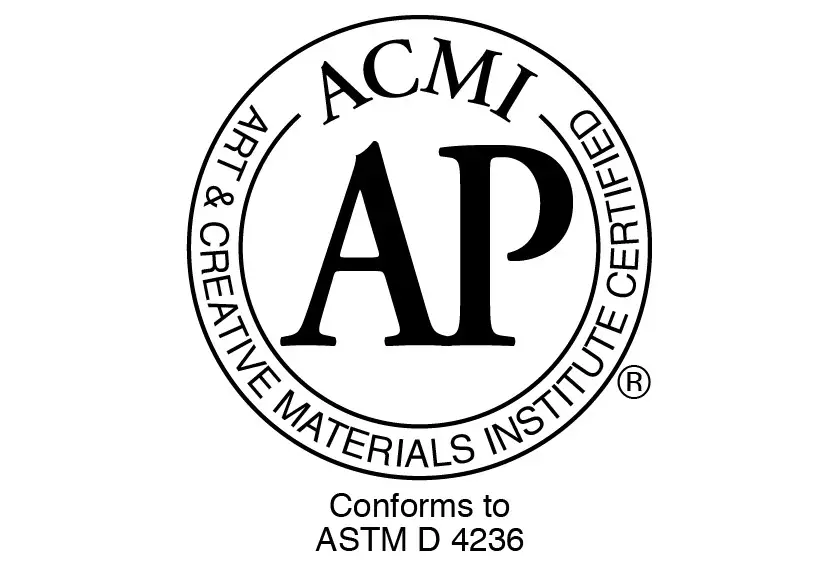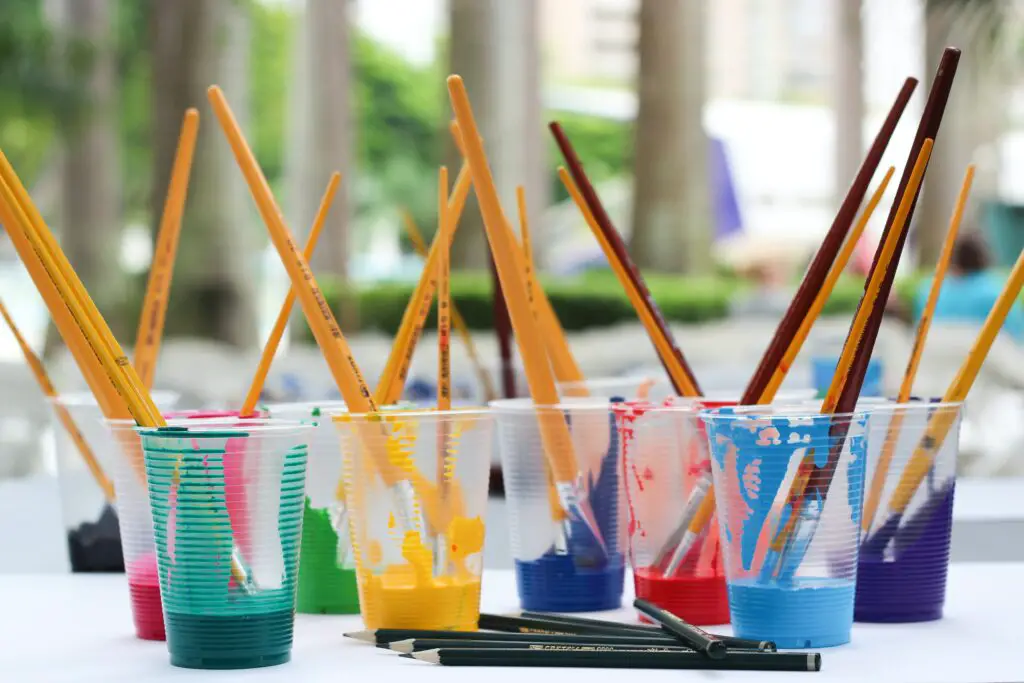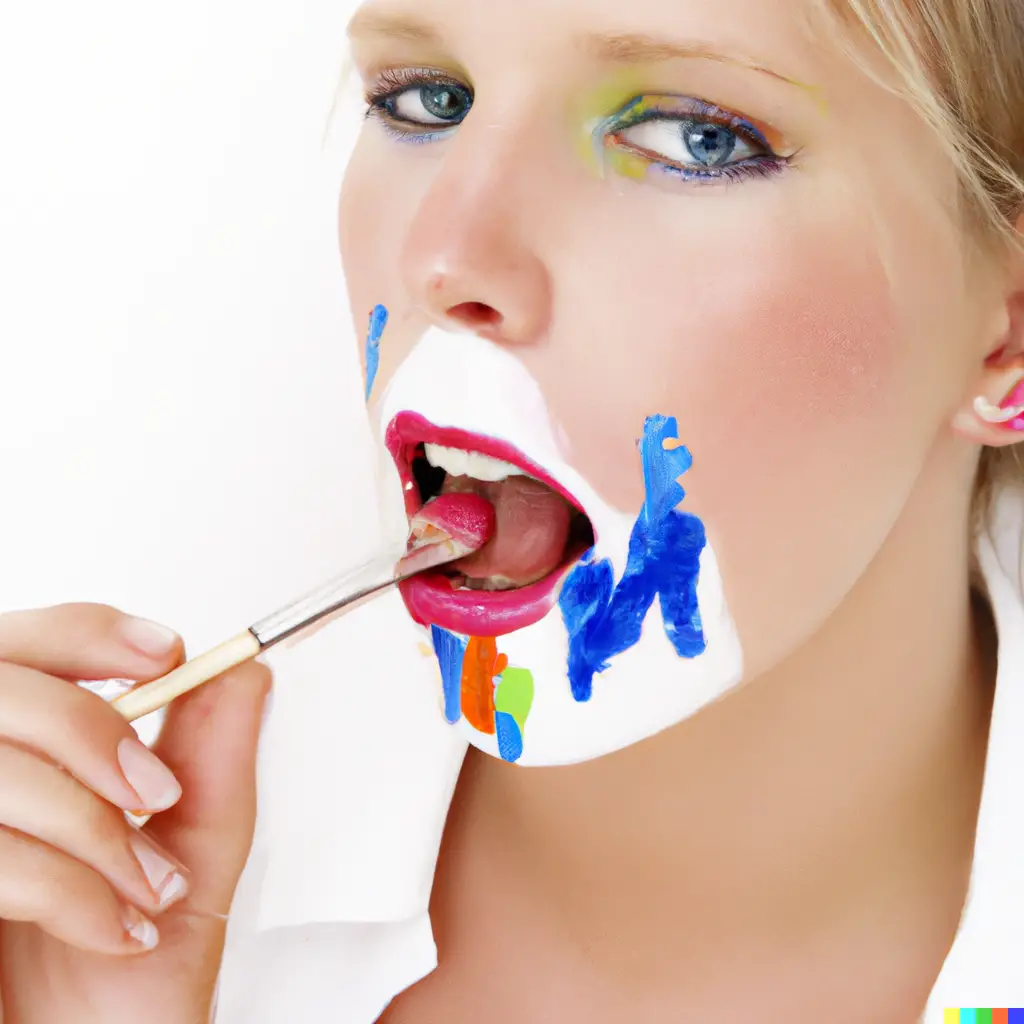Sometimes totally unexpected things can happen to artists, like accidental ingestion of acrylic paint. Maybe your child has eaten those bright, beautiful colored acrylic paint or the total in the art zone artists might have drunk the acrylic paint water. In either case, let’s see if it is safe to eat acrylic paint.
It is unsafe to eat acrylic paint especially if using artists-grade acrylic paint. Acrylic paint may contain heavy metals like cadmium that can attack kidneys and cause decreased bone density. Effects may depend on the quantity eaten and the exposure time.
In case of accidental ingestion of acrylic paint, give two or more glasses of water to dilute the paint, ONLY IF CONSCIOUS, and see a doctor. Even though acrylic paint is acutely nontoxic in its intended use, it may cause irritation and adverse health effects in chronic or unintended use.
Can you eat acrylic paint?
Even though acrylic paint is considered nontoxic, it is unsafe to eat acrylic paint. In case of accidental ingestion as the paint itself or as diluted versions, wash out your mouth and drink two or more glasses of water, only if conscious. Chemical exposure to the body should be limited.
Seek immediate medical attention in case of accidental ingestion. Your doctor can address the situation the best, according to individual circumstances. Also, acrylic paint tastes nasty, and you should not be putting them in your mouth.
The effects of acrylic paint consumption depend on how much acrylic paint was consumed, and for how long of a period. Eventually, if the paint has cadmium, it can attack the kidneys and cause decreased bone density.
Ben Gavett, Director of our Health and Safety Department, Golden Paints
It is not safe and not recommended to eat acrylic paint in any given situation. Eating acrylic paint can cause gastrointestinal irritation and even more adverse health effects like cancer if the paint contains cadmium or similar heavy metal.
Acrylic paint poisoning symptoms…
Upon ingestion of acrylic paint, mild stomach irritation, nausea, and vomiting can occur. Eye contact with acrylic paint may cause serious eye damage. Prolonged or repeated skin contact with acrylic paint may cause skin irritation.
I have written a whole article about, ‘Is acrylic paint harmful? (In different routes of exposure)‘ There you will find the extent of harmfulness in different routes of exposure to acrylic paint. You can become a successful, informed artist with no adverse effects from using a chemical to create beautiful art.
What happens if a child eats acrylic paint?
The same immediate actions of acrylic paint ingestion should be followed with children. Wash the child’s mouth and give them two glasses of water to drink. Immediately seek medical attention or contact the nearest poison control center. Prevention of acrylic paint ingestion is the best path.
Acrylic paint can be toxic to children as the paint can have potentially harmful chemicals, although not been found to be a chronic health hazard according to the current knowledge. You should only give children artists acrylic paint under the supervision of an adult or when the child is mature enough to handle paint properly without accidentally ingesting it.

As a parent who supervises children in using art materials, you need to be familiar with the products and chemicals. You should never allow children to eat acrylic paint. Also, do not let them use it as body paint. All activities that involve unnecessary exposure to chemicals should be limited.
Always give only student-grade paints to children below the 6th-grade level. Student-grade acrylic paint typically does not use heavy metals like cadmium in them. Always read the paint tube label and check for any labels or cautionary messages.
Unsafe/ toxic ingredients in acrylic paint
Acrylic paint is made up of water, acrylic polymer, pigments, and additives. Acrylic polymer is essentially plastic. Pigments are either natural or organic. Pigments may contain heavy metals like cadmium, nickel, cobalt, chromium, carbon black, lead, and crystalline silica which are known carcinogens.
As you can see acrylic paint is a synthetic plastic that may even contain heavy metals. So it is never considered edible and can even cause adverse health effects. However, the different heavy metals in acrylic paint behave differently.
Metal pigments like cobalt, nickel, and chromium in acrylic paint are tightly bound due to the nature of their bonds. Thus they are less soluble and bioavailable. This means these metals have relatively less ability to cause adverse health effects.
Cadmium pigments are on the other hand. They are less stable. When cadmium pigments are exposed to moisture and light, they tend to break down, becoming more bioavailable. So a clear glass container of brush washing water can contain more bioavailable cadmium.
Some acrylic paint products such as varnishes, acrylic mediums, and flow aids need to be used with care. Warnings are displayed on these product labels. Golden Paints for example has leveled these products with an ‘X’ on an orange background. Do not spray apply these Golden Paint products.
Eating or ingestion of dry acrylic paint pieces also has a risk of choking. Dry acrylic paint is a polymeric matrix where harmful pigments are trapped inside the polymer matrix. However, these chemicals can release in your body when exposed to acids and other chemicals. Also, dry acrylic paint is essentially plastic and it is best kept away from your body.
Check the label to identify harmful ingredients
Reading labels is as important as the safe use of art materials. Most acrylic paints will contain AP (Approved Product) and CL (Cautionary Label) Seals given by Art and Creative Materials Institute (ACMI) AP. Even though an AP product says nontoxic, it does not mean the particular acrylic paint can be used freely without care.

The toxicological testing used when determining the toxicity of a product is much more debatable. Most chemicals in acrylic paints are not tested for chronic health hazards. Even though there is no known chronic health hazard in acrylic paint, there can be unknown risks. So you as a consumer should not misunderstand the labeling which says “nontoxic”.
Golden paints for example use a marble sign instead of displaying ‘AP’. A marble represents that the product is relatively safe but should still be kept out of one’s mouth. This is to stop the misunderstanding of the label ‘AP nontoxic’ and bring the artists aware that the exposure to products should be limited.
You will also see ‘California Prop 65 Warnings’ on labels such as “WARNING: This product contains a chemical known to the State of California to cause cancer”. Proposition 65 is an act that has listed chemicals causing cancer and/or reproductive toxicity.
What happens if you drink acrylic paint water?
Acrylic paint water can contain metals like cadmium. Glass brush-washing container has both moisture and exposure to light which breaks down cadmium pigments and releases more bioavailable cadmium. So if you happen to drink paint water you will be exposed to cadmium which can attack your kidneys and bones.
This is the reason why you shouldn’t throw paint water in the sink. When acrylic paint is moist, the higher bioavailability and the higher the damage would be. Therefore when you dispose of acrylic paint, make sure you dry it first, so that the harmful metals cannot move in the environment.
Putting brushes in the mouth may expose you to harmful chemicals…
I have seen some artists have a bad habit of putting brushes in their mouths to shape them and wet the bristles. They have not seen any adverse effects of this habit. This might be because the exposure to harmful chemicals is pretty much low as the brush is already washed up.

However, as you are putting brushes in your mouth as a habit, for a longer period, you are exposed to harmful metals and chemicals for a longer period. Also, remember that most toxicological tests are not done to determine chronic health hazards in many cases.
This is not a good or safe habit at all and you should not be putting the brushes in your mouths. Try to use water instead.
How to dispose of acrylic paint properly?
When disposing of acrylic paint, always let the paint dry. This way harmful pigments are trapped inside the acrylic polymer. The system is called a polymeric matrix. When you dispose of dry acrylic paint, the metals will not be added to the waterways. Dispose of as per local regulations.
Some artists use to pour the paint water onto the cat litter once they finished painting. Cat litter will clump up with acrylic paint water. Then you can throw away the clumped-up cat litter. Alternatively, you can let acrylic paint dry in layers and then dispose of it safely.
Using all acrylic paint is a much better choice than disposing of them, especially if you are using expensive artist-grade acrylic paint. You can use a stay-wet palette to keep acrylic paint wet and workable for a long. Most importantly handle cadmium-pigmented paints as hazardous waste.

Is acrylic paint nontoxic?
Acrylic paint is considered nontoxic according to current legislation in its intended use. Most acrylic paints have the AP (Approved Product) Seal given by ACMI (Artists Craft Materials Institute, Inc.) as a certification that the paint has no known chronic or acute human health hazards when use as intended as an art material.
Artist Paints are regulated by the Consumer Product Safety Commission, while cosmetic materials are regulated by FDA (Food and Drug Administration). These cosmetic products regulated by FDA have an ingredient list on the label whereas acrylic paint does not.
However, as a wise man once said, always limit your exposure to chemicals. A chemical compound might not be found to be toxic or hazardous today but eventually will be discovered as a toxic or unsafe compound, especially as a chronic health hazard.
Is acrylic paint edible?
Acrylic paint is not suitable or safe for eating in other words it is nonedible. Acrylic paint is made from water, polymer, pigments, and other additives. Apart from the solvent, water all other compounds are chemicals. Humans should limit their exposure to chemicals at all costs.
We only know a little about chemicals and their effect on our bodies. As said before we might discover a compound as unsafe and toxic under different conditions, such as in acidity. Therefore we should limit chemical usage as much as possible.
We need to limit exposure to acrylic paint even if it is a relatively nontoxic material in its intended use. In some cases, acrylic paint manufacturers have encapsulated harmful acrylic paint pigments like cadmium sulfides in the polymeric matrix to make them less bioavailable.
These encapsulated cadmium pigments can even change their bioavailability in acidic environments and more bioavailable. However, when I asked Golden Paints about cadmium pigment encapsulation, they said that the pigments are trapped in a polymeric matrix only when they are dry. In fluid conditions, cadmium is more bioavailable.
Also, oxidized cadmium pigments can absorb into our bodies easily because of their high solubility and bioavailability.
Historic artists who snack on paint…
The Washington Post on Nov 25, 1988, posted about Vincent van Gogh the famous artist has been drinking strong liquors and possibly eating paint contributing to his insanity. The strong liquor he has been drinking has given him fits, hallucinations, and possibly a pica. Pica means the appetite for food items like paint.
According to Vincent’s physician, Dr. Peyron’s notes, Vincent wanted to poison himself by drinking turpentine and eating paint. So he was not allowed to enter his studio while he is having the attacks. As you might know Vincent van Gogh is an oil painter, and eating oil paint is more detrimental than acrylic paint.
How to prevent acrylic paint ingestion?
Artists of any age need to know how to avoid the unsafe use of acrylic paint. Children from an early age need to be introduced to these safe practices, to act as responsible artists in the future. Following are some best practices to follow when using art materials like acrylic paint.
- Read the product labels. Look for warnings and cautions on the label.
- Avoid drinking or eating while painting to avoid accidental paint ingestion
- Wash any acrylic paint stains on the skin as soon as finish painting
- Paint in a well-ventilated area
- Do not use acrylic paint on the skin, avoid ingestion, and avoid eye contact
- Never use acrylic paint for food decoration or dishware decoration
- Avoid painting with fingers, or tongue
- Avoid tattooing with acrylic paint.
Conclusion
It is extremely unsafe to eat acrylic paint even though the paint tube label says it is non-toxic. However, most chemicals used in acrylic paints are not fully tested for chronic toxicity meaning the long-term or repeated use of the chemical. So you should always limit exposure to acrylic paints by avoiding excessive skin contact, completely avoiding eye contact, and eating acrylic paint.

